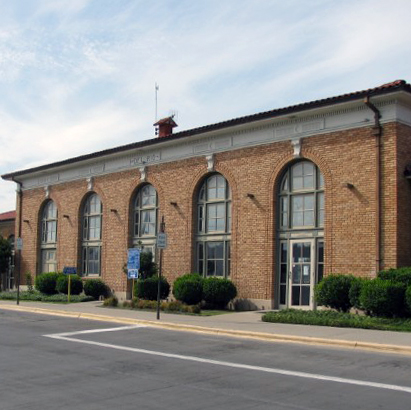Del Rio, TX (DRT)
Del Rio is situated in southwest Texas along the Rio Grande River. The intermodal center, built in the 1920s, is dominated by large, round-arch windows and includes classical detailing.

100 North Main Street
Del Rio, TX 78840
Annual Station Ridership (FY 2023): 1,817
- Facility Ownership: City of Del Rio
- Parking Lot Ownership: City of Del Rio
- Platform Ownership: Union Pacific Railroad
- Track Ownership: Union Pacific Railroad
Todd Stennis
Regional Contact
governmentaffairsnol@amtrak.com
For information about Amtrak fares and schedules, please visit Amtrak.com or call 1-800-USA-RAIL (1-800-872-7245).
The Del Rio railroad station was built in the 1920s to replace an earlier wooden structure. It consists of a center block flanked by two recessed wings, one of which originally served as an outdoor waiting room. Constructed of buff brick, the principal façade is dominated by five large, round-arch windows accented with scrolled keystones. Below the hipped roof of Spanish red tile, an entablature wraps around the center block. It features classic dentil molding as well as decorative panels, one of which reads “DEL RIO.” Today, the building serves as the Del Rio Regional Transportation Center, a city-staffed intermodal facility that accommodates Amtrak, local buses and taxis; an addition has been added to the east.
In fall 2023, Amtrak completed a $3.8 million project at the station designed to provide customers with a smoother, brighter and more accessible journey. Amtrak, working with the city, made investments that included the construction of a 650-foot-long concrete platform and upgrades to station signage. A mobile lift enclosure, parking stalls, public right-of-way access and energy efficient LED light fixtures along the platform and pathways, were among the improvements meeting the specifications of the Americans with Disabilities Act.
Del Rio is situated in southwest Texas along the Rio Grande River. It is connected with its Mexican sister city, Ciudad-Acuña, via the Del Rio-Ciudad-Acuña International Bridge and the Lake Amistad Dam International Crossing. As early as the 18th century, the Spanish established a presidential complex in Ciudad-Acuña, and some began settling on what is now the United States side of the Rio Grande. The proximity of present-day Del Rio to the San Felipe Springs made it a prime location for a settlement, especially in the hot, arid Texas climate. The springs provide 90 million gallons of water per day. This abundant water supply attracted the attention of the Southern Pacific Railroad (SP) in the late 19th century, and by 1883 Del Rio was connected by rail.
Local lore suggests that the town of San Felipe del Rio got its name from a mass performed by local explorers on St. Philip’s Day, 1635. The name was eventually shortened to “Del Rio.” Early developers acquired tracts of land from the state of Texas, built irrigation canals in return, and then sold the land to farmers for profit. The town developed slowly until after the Civil War.
The town’s later growth was tied to the railroad, the military, agriculture and ranching, retail business, and government employment. Del Rio’s proximity to Mexico also attracted many tourists. In the 1880s, sheep and goat ranching developed as a result of the railroad. During that time, SP built a line from west to east, linking up with the Galveston, Harrisburg and San Antonio Railroad 40 miles west of Del Rio.
Del Rio is home to the Laughlin Air Force Base, the busiest pilot training base in the U.S. Air Force. The Army Air Corps opened Laughlin Field in 1942, but closed it in 1945 when World War II ended. Tension escalated once more during the Cold War, and the base was rebuilt. In 1962, Laughlin-based U-2s took photographs of medium range ballistic missiles in Cuba. This photo intelligence sparked the Cuban Missile Crisis.
The city’s history is preserved at the Whitehead Memorial Museum in downtown Del Rio. The museum consists of several historically significant buildings and focuses on the 19th century.
Platform only (no shelter)
Features
- ATM not available
- No elevator
- No payphones
- No Quik-Trak kiosks
- No Restrooms
- Unaccompanied child travel not allowed
- No vending machines
- No WiFi
- Arrive at least 30 minutes prior to departure
Baggage
- Amtrak Express shipping not available
- No checked baggage service
- No checked baggage storage
- Bike boxes not available
- No baggage carts
- Ski bags not available
- No bag storage
- Shipping boxes not available
- No baggage assistance
Parking
- Same-day parking is available for free
- Overnight parking is available for free
Accessibility
- No payphones
- Accessible platform
- No accessible restrooms
- No accessible ticket office
- No accessible waiting room
- No accessible water fountain
- Same-day, accessible parking is available for free
- Overnight, accessible parking is available for free
- No high platform
- No wheelchair
- Wheelchair lift available
Hours


 Amtrak established the Great American Stations Project in 2006 to educate communities on the benefits of redeveloping train stations, offer tools to community leaders to preserve their stations, and provide the appropriate Amtrak resources.
Amtrak established the Great American Stations Project in 2006 to educate communities on the benefits of redeveloping train stations, offer tools to community leaders to preserve their stations, and provide the appropriate Amtrak resources. For more than 50 years, Amtrak has connected America and modernized train travel. Offering a safe, environmentally efficient way to reach more than 500 destinations across 46 states and parts of Canada, Amtrak provides travelers with an experience that sets a new standard. Book travel, check train status, access your eTicket and more through the
For more than 50 years, Amtrak has connected America and modernized train travel. Offering a safe, environmentally efficient way to reach more than 500 destinations across 46 states and parts of Canada, Amtrak provides travelers with an experience that sets a new standard. Book travel, check train status, access your eTicket and more through the